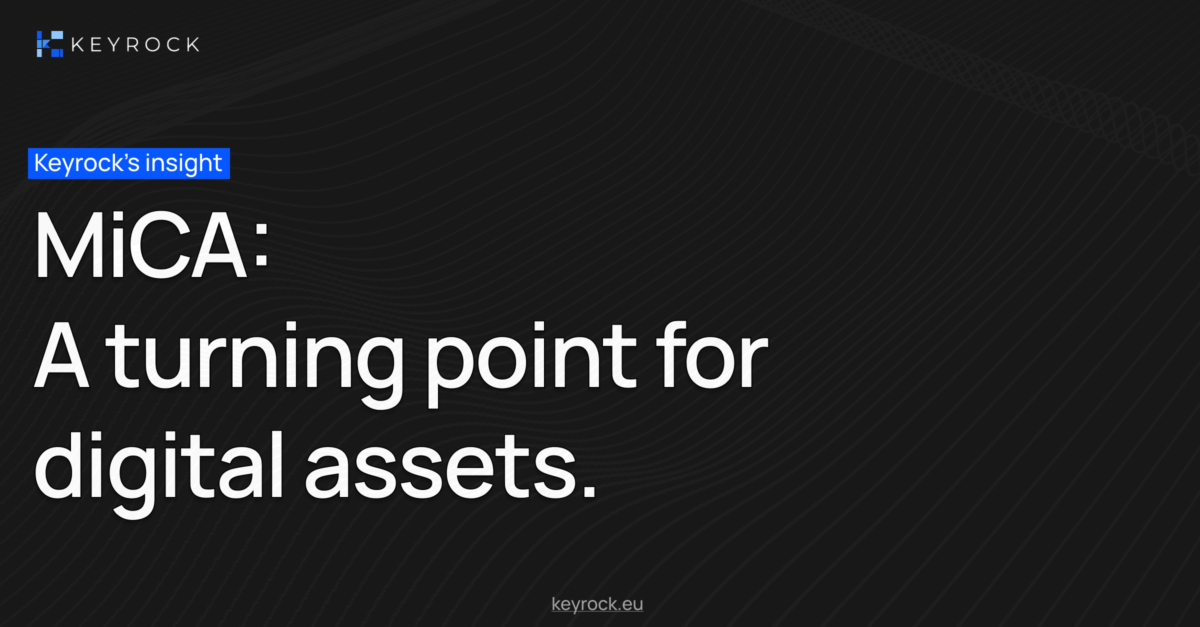How Keyrock is Approaching the Latest Crypto Regulations
MiCA is providing a new framework for crypto in the EU. Here’s Keyrock’s approach in light of the most recent regulation.
MiCA is providing a new framework for crypto in the EU. Here’s Keyrock’s approach in light of the most recent regulation.

On April 20th, one of the most significant global events for the regulatory clarity of digital assets to date occurred. Markets in Crypto Assets Regulation (‘MiCA’) was formerly voted and adopted by the European Parliament, handing down a set of guidelines to which any issuer of digital assets or crypto service provider within the 27 EU blocs must adhere, including non-EU firms targeting customers in the EU.
MiCA marks a new era for the crypto industry in the European Union. From this regulatory milestone, local and foreign companies will have set guidelines that will allow them to more seamlessly offer products and services to consumers. Consumers, on the other hand, will be able to explore novel financial and technical services with more confidence and security.
Companies have approximately 12 to 18 months to implement the requirements as from June 2023, during which time a spectrum of regulatory crypto compliance will exist among digital asset firms.
Keyrock has been operating in the EU since 2017, navigating the regional regulatory landscape prior to MiCA. During this period of regulatory ambiguity, we strived to apply the best regulatory standards and developed our own methodology of market resilience.

MiCA aims to create a guiding legal framework for the regulation of crypto assets in the EU by clearly defining the regulatory treatment of crypto-assets that are not covered by existing financial services legislation.
Like nearly every digital asset company in the world, those in the EU have been offering services and products to individuals and businesses without full legal clarity. The net result of MiCA, however, will be an easier process for companies to operate across borders within the EU to offer digital assets and related services. This will help foster innovation and growth in the crypto industry while also providing greater protection for investors.
The rest of the world has its eyes on the EU and its implementation of MiCA. There are two primary reasons governments and digital asset firms will be paying even closer attention to the crypto industry in the EU in the months to come.
First, the roll-out of MiCA will provide a framework for foreign companies to offer digital asset products and services to EU consumers. For firms that are not already active in the EU, this provides them a clear path to accessing a large, crypto-savvy, and multinational market.
Second, foreign governments and regulators will pay close attention to how MiCA’s guidelines impact the crypto ecosystem as they are building their own legislative frameworks. Just as the world paid close attention to the EU’s groundbreaking privacy legislation with GDPR, so too has the EU taken a stance on the relationship between regulation and innovation. The U.K. is looking into establishing its own stablecoin and crypto-asset services rules, similar to MiCA.

Unsurprisingly, MiCA is not a swift process. The implementation and enforcement of the new regulation will be handled by the European Securities and Markets Authority (‘ESMA’). ESMA is an independent EU authority that contributes to safeguarding the stability of the EU’s financial system. ESMA will work with national regulators to ensure that companies comply with MiCA guidelines and will have the power to impose sanctions on those who do not comply.
All of this is to say that, despite regulatory clarity being on the horizon, it is a market that innovates very fast. Defi and NFT activities are out of the scope of MICA and further innovation may be expected until the implementation of the regulation. It is the responsibility of digital asset service and product providers to self-maintain high standards and transparent practices as MiCA is rolled out across the region. For Keyrock, that entails continuing the methodologies we’ve implemented for the past five years. This period is also a critical one for regulating bodies, which will need to equip themselves for MiCA by hiring staff with crypto expertise and adopting their own methodologies for how to respond to future crypto innovations that may fall outside of MiCA’s language.
From very early on, Keyrock has participated in working groups with other industry players with the objective of discussing and helping shape regulation in a way that does not stifle innovation by working hand-in-hand with regulators. Prior to MiCA, Keyrock has monitored the best practices from international supervisory bodies and implemented those standards of regulation.
Keyrock is already preparing for compliance with MiCA, built off of years of robust self-imposed regulation. This 12-18 month “grace” period during which MiCA will be further rolled out is an opportunity for all crypto entities to adjust their business practices. For Keyrock, it is an opportunity to maintain our strong record of compliance and adjust as needed.
Keyrock is very excited to be located in Brussels where key decisions have been made to develop the first world crypto regulatory framework. We believe it represents a great opportunity for Europe to position itself as a leader in this industry. Keyrock is excited to continue its world-class market-making services in this future that MiCA has charted.